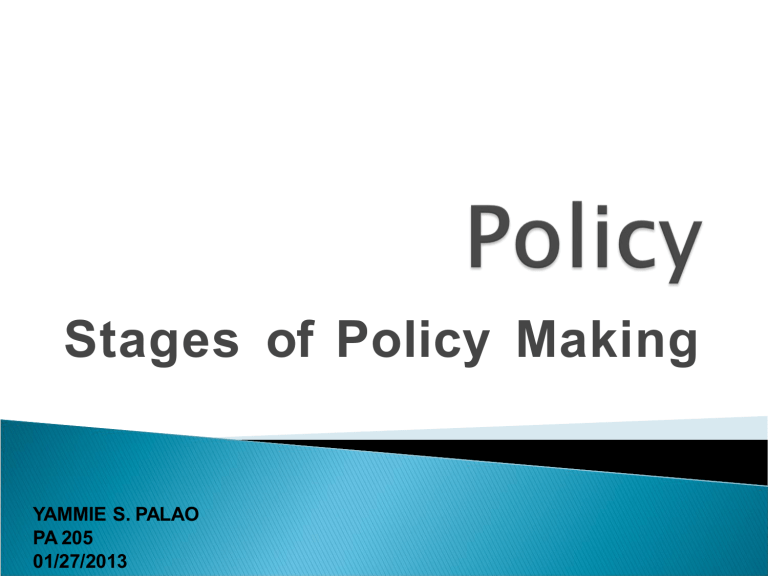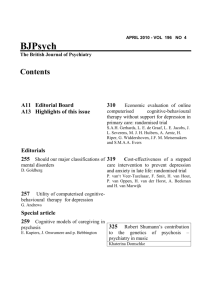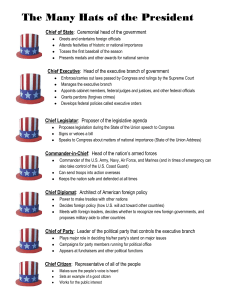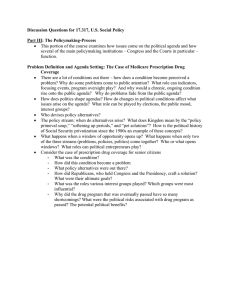
Stages of Policy Making YAMMIE S. PALAO PA 205 01/27/2013 A definite course or method of action selected (by government, institution, group or individual) from among alternatives and in the light of given conditions to guide and, usually, to determine present and future decisions. A specific decision or set of decisions designed to carry out such a course of action. YAMMIE S. PALAO PA 205 01/27/2013 Such a specific decision or set of decisions together with the related actions designed to implement them. A projected programme consisting of desired objectives and the means to achieve them. A business dictionary defines Policy in the area of Government as: (1) Basic principles by which a government is guided; (2) Declared objectives which a government seeks to achieve and preserve in the interest of national community. YAMMIE S. PALAO PA 205 01/27/2013 Thus, it would be incumbent for us to have our preferred definition, that is: “Policy is a decision-making framework or course of action to achieve a desired effect or change .” In the context of the public sector, policies support political purposes by Government or administrative directions by organizations in response to the changing world around them. YAMMIE S. PALAO PA 205 01/27/2013 Policy can: Be broad and visionary. Set direction. Express standards, behaviours, and expectations to guide actions. Be a concept or stated position of intended outcomes. Be a statement of principle. Policies are distinct from procedures and guidelines, which are operational instructions or processes for applying a policy decision. Operational procedures interpret policy and define activities that must be carried out to implement the directions and goals set by policies. They are designed to achieve outputs. To reach consistent results, they place boundaries on how much individual discretion is permitted when interpreting policy. I Issue Identification ◦ Publicized demands for government action can lead to identification of policy problems. ◦ Attention that prompts the need for government action. Agenda Setting ◦ Government begins to give serious consideration YAMMIE S. PALAO PA 205 01/27/2013 Policy Formulation ◦ Policy proposals can be formulated through political channels by policyplanning organizations, interest groups, government bureaucracies, state legislatures, and the president and Congress. ◦ Development of possible solutions; consideration of several alternatives YAMMIE S. PALAO PA 205 01/27/2013 Policy Adoption/Legitimization ◦ Policy is legitimized as a result of the public statements or actions of government officials; both elected and appointed—the president, Congress, state legislators, agency officials, and the courts. This includes executive orders, budgets, laws and appropriations, rules and regulations, and administrative and court decisions that set policy directions. YAMMIE S. PALAO PA 205 01/27/2013 Policy Implementation ◦ Policy implementation includes all the activities that result from the official adoption of a policy. Policy implementation is what happens after a law is passed. We should never assume that the passage of a law is the end of the policymaking process. Sometimes laws are passed and nothing happens! YAMMIE S. PALAO PA 205 01/27/2013 1. Preparation: Prepare well for changing policies. Conduct the necessary research to get to know as much as possible about the issue. 2. Planning: Plan carefully for policy change. To ensure that your overall strategy makes sense, and that changing policies is a necessary and appropriate part of it, strategic planning is essential. YAMMIE S. PALAO PA 205 01/27/2013 3. Personal contact: Establish or maintain contact with those who influence or make policy. Personal relationships, even with opponents, are the key to successful advocacy of all kinds, and changing policy is no exception. 4. Pulse of the community: Take the pulse of the community of interest to understand what citizens will support, what they will resist, and how they can be persuaded. You will have a far greater chance of success if you set out to change policies in ways the community will support, or at least tolerate, than if you challenge people’s basic beliefs. 5. Positivism: Where you can, choose tactics that emphasize the positive. 6. Participation: Involve as many people as possible in strategic planning and action. Try to engage key people, particularly opinion leaders and trusted community figures, but concentrate on making your effort participatory. That will give it credibility. YAMMIE S. PALAO PA 205 01/27/2013 7. Publicity: Use the media, the Internet, your connections, and your imagination to keep people informed of the effort and the issues, and to keep a high profile. 8. Persistence: Policy change can take a long time. Monitor and evaluate your actions to make sure they are having the desired effect, and change them if they are not. YAMMIE S. PALAO PA 205 01/27/2013 THAT ENDS MY REPORT THANK YOU! YAMMIE S. PALAO PA 205 01/27/2013



